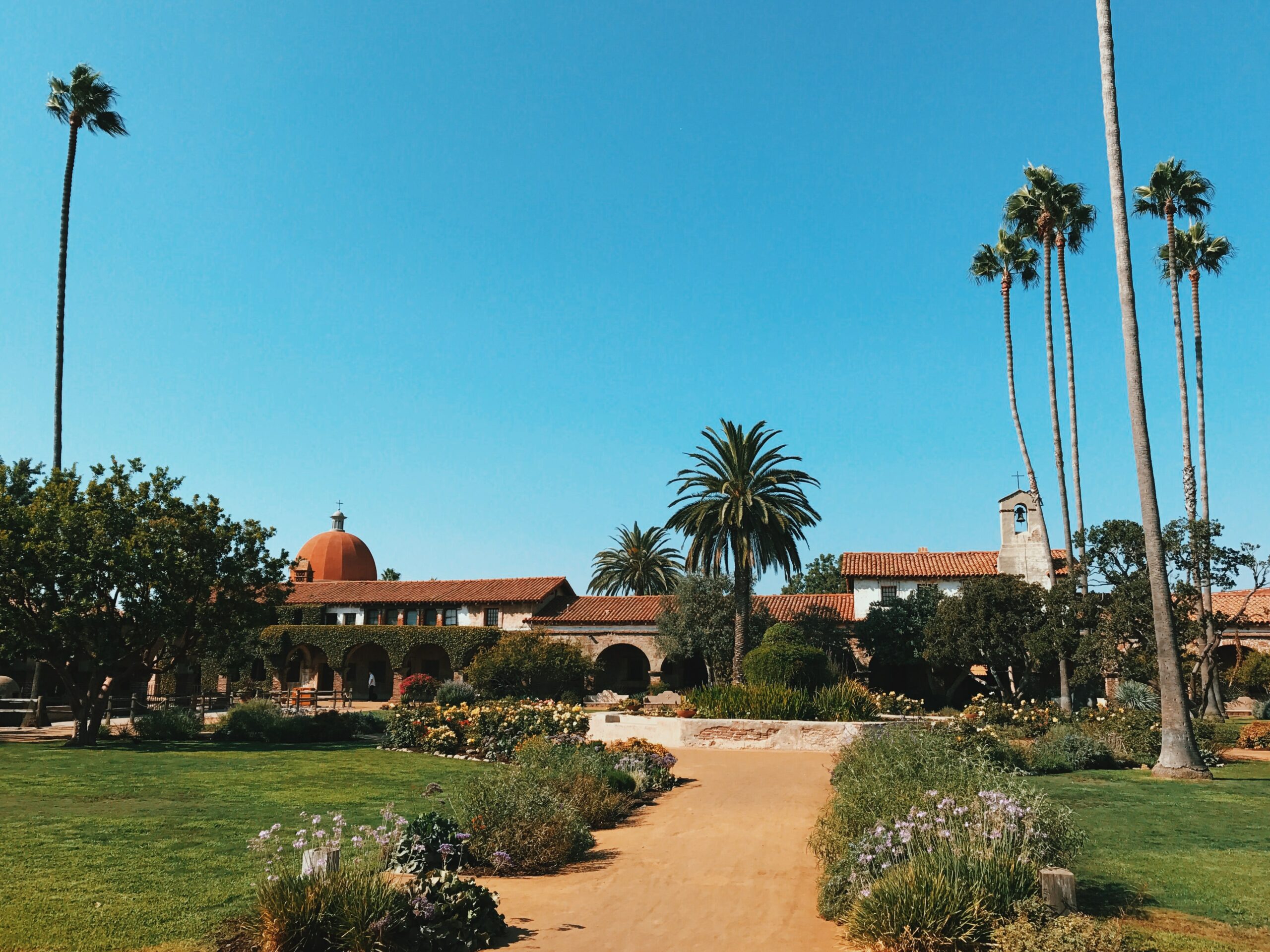 By Tim Sitterley, US Regional Director, West
By Tim Sitterley, US Regional Director, West
Early in our marriage Linda and I were visiting the old Franciscan Mission in Santa Barbara California. We were in the mission’s visitor’s center, and I noticed a large and very old bible open to the Gospel of John. The Bible was in Latin, and since I had taken four years of Latin in high school, I was naturally compelled to try and impress my wife with my translation skills. About three verses into my translation the reflected image of an individual standing behind us appeared in the glass of the display case. The individual turned out to be a Franciscan friar, but since the hood of his cowl was up, all we could see was blackness where his face should be. I nudged Linda and said, “Look! It’s the angel of death.”

Booming resonant laughter filled the visitor center, and as I turned around my hand was firmly grasped by the beaming friar who looked like anything but death. Happy to see that he appreciated my somewhat irreverent sense of humor, we entered into a conversation about where I learned Latin, and the differences between my classical Latin and the Vulgate Latin spoken in the Catholic Church today.
Then, out of the blue he invited Linda and I to attend the Mass that was about to start in the main sanctuary. He said the service was totally in Latin, and that I would enjoy it. I made it clear we were not Catholic, but he assured me we were welcome to sit in the back, and as long as we didn’t come forward for communion, we could participate in everything else.
So there we were, sitting in the next to last row in a service neither of us had ever experienced. As the liturgy progressed, I at least had a hint to what was being said. The priest would recite “Agnus Dei” (Lamb of God) and the congregation would reply “qui tollis peccata mundi” (who takes away the sins of the world). They would stand up, so we would stand, but as we stood, they were sitting back down. They would kneel on the rail attached to the pew in front of them, so we would awkwardly kneel. But of course, they were standing back up as we were kneeling. This comedy routine lasted until deacons came down the center aisle with an offering basket on the end of a long pole, at which point Linda and I quietly made our exit. We totally missed the benediction.
I share this story because it demonstrates two things. First, it speaks to the response we’ve received from many when we encourage following the liturgical calendar, the Revised Common Lectionary, and the inclusion of various elements into the weekly worship service. And second, it also points to the fact that first-time visitors to our weekly service may be just as confused as Linda and I were, if we don’t adequately communicate what we are doing…and why.
First, let’s look at the concept of liturgy itself.
One of the first pushbacks I hear regarding the adding of liturgical elements is that liturgy is Catholic…and somehow therefore evil. First, our Catholic brothers and sisters are part of the same Body of Christ we are. And second, to make it very clear, liturgy is totally catholic. But if you are paying attention, I spelled catholic with the lower case “c”.
The word catholic means universal. Our liturgy has elements dating back to the Apostolic age. It has been used by Christians on every continent and in every age. The liturgy is filled with Scripture. Over the course of history, the church has dropped elements and added other elements. It isn’t my liturgy or your liturgy, or a Catholic/Lutheran/Episcopal/etc. liturgy. It is a catholic liturgy — a gift to us from the saints who went before us (even before there were any denominations to name). Isn’t it far more narrow minded to craft a service to meet the preferences and particularities of your individual congregation? Isn’t it far more presumptuous for a pastor to imagine he knows better than his sainted elders or than the church universal (dare I say catholic)?
Someone once said the liturgy is like a fine banquet, prepared over hours under the direction of a master chef. Services that are cooked up on the pastor’s computer each week are like fast food meals – not nearly as nutritious or memorable. Because the liturgy is catholic – spanning ages and places – it serves to feed us a nutritious and enduring meal – the meal of Christ in Word and Sacrament.
Another argument I frequently hear is that the liturgical calendar and weekly liturgical elements are too repetitive…as if that’s somehow a bad thing. I’m amused by this response, simply because I grew up in a denomination where I knew EXACTLY what the service would look like each week, no matter which congregation I was visiting in the world. The fact is, we like repetition. Consider our secular celebrations:
In January, we stay up till midnight and sing an ancient Scottish song no one actually knows the words to. February, its flowers and heart-shaped boxes of candy. March, we dress in green and drink green beer. April, bunnies and eggs. May, margaritas and tacos. July, we blow stuff up. November, we eat way too much, and are thankful we can go shopping the next day. This is just the United States. Around the world the list of annual events is endless. Repetition keeps us grounded in our culture and lets us know where we are.
Liturgy…not only at the calendar level…but more importantly at the weekly congregational level, keeps us grounded in our faith, and continually reminds us of what is most important in our worship. I can give a poor sermon (I’ve been told) but I can still take comfort in knowing that through the liturgy of our weekly worship experience, the Gospel has been presented through the singing and prayers. Through the various scripture readings, the words of the prophets and apostles have been spoken. And through the elements of the Lord’s Supper, the congregation’s gaze has been turned to Jesus. None of this is an excuse to not put the time into the message. But it does remind me that the message is just a part of the greater tapestry of worship, and even if it is weak, the liturgy still delivers the good news of Jesus each week.
George Stoddard is a retired Lutheran pastor, and a good friend of mine. I recently sat down with George and asked him to talk about the Lutheran liturgy, and more importantly, what that liturgy meant to him. He listed off liturgical elements that I was either totally unfamiliar with, or wouldn’t be a good fit in most of our services. But he also spoke of elements that would add just one more layer of understanding to our weekly gatherings.
The thing that resonated the most, however, was George’s description of liturgy as the outline for our weekly corporate conversation with God. Whether it’s the singing together of songs of worship and adoration, or the corporate call and response, or the corporate prayers of confession, we all enter into a familiar and orchestrated conversation with the God who tells us that wherever two or three are gathered in his name there he is in the midst of them. Yes, there is time during the week for personal worship and prayer and confession. But when we stand together as one congregation, we are reminded that we are not the audience watching the performance on stage, we are participating together in an offering of worship and faith to the true audience…the Triune God. The liturgy simply gives us a script for that conversation, and the liturgical calendar takes us through the greater narrative of the gospel story.
Around the year 1000 AD, Prince Vladimir of Russia, a pagan, sent envoys to explore different religions and return to him with a report. The envoys who visited the Hagia Sophia Church in Constantinople returned with this report, “We knew not whether we were in heaven or earth… We only know that God dwells there among men, and their service is fairer than the ceremonies of other nations.” Within a year Prince Vladimir was baptized into the Orthodox faith, and Orthodoxy became the official religion of Russia.
Yes, we need to be aware of the needs of first-time visitors. Our actions should always be explained, and it be made known to visitors that they are included. Even among our long-time members, we should never assume that everyone knows why we have introduced new elements to the worship liturgy they already know well. But when they do know the why behind the action, then the familiarity becomes a source of comfort that opens the door to that place where “God dwells there among men.”
I saw this driven home so poignantly by a video of a congregation in Kentucky gathered in the parking lot next to what little was left of their church building. The tornado had removed the roof. The organ was gone. The pews were gone. The big sign on the front of the building was gone. Every physical thing that defined them as a church was blown away. And yet they gathered because the calendar told them it was time. And they stood there in that parking lot in conversation with God, following the familiar liturgical roadmap that had led them…in some cases…for generations.
The liturgy brings Christ to earth and us to heaven. Jesus locates himself in his Word and in the Sacraments. And the liturgy of the church, in all its variations, has provided comfort and instruction and grounding through persecution, war, natural disasters and the constant influence of cultural change for two millennia. May God guide our liturgy to the point that members and guests experience God’s dwelling among men.



Thanks Tim for this excellent and timely article!
Thank you so much, Pastor Tim, so inspiring. A focus I had not seen towards liturgy “God dwells there among men”, just beautiful!. I just pulled some exerpts from your article, translated and shared with my comments to a GCI Latinamerican WhatsApp group. Blessings from Tijuana!
Thanks Tim for explaining the value of liturgical elements in the corporate life of the church.
Thank you so much Pastor Tim. I never saw liturgy this way before; this is so eye opening! I just pulled some exerpts from you article, translated them to Spanish, added my comments and shared with a Latinamerican GCI WhatsApp group. Blessings.
Thanks Tim. For me, a good resource that addresses both the pluses and the minuses of the Protestant Revolutions’ cutting back on rote liturgical and ceremonial practices in the worship service is a book by Alister McGrath, entitled “Christianity’s Dangerous Idea.” As with much of life, keeping a balance and avoiding extremes leads to better outcomes.